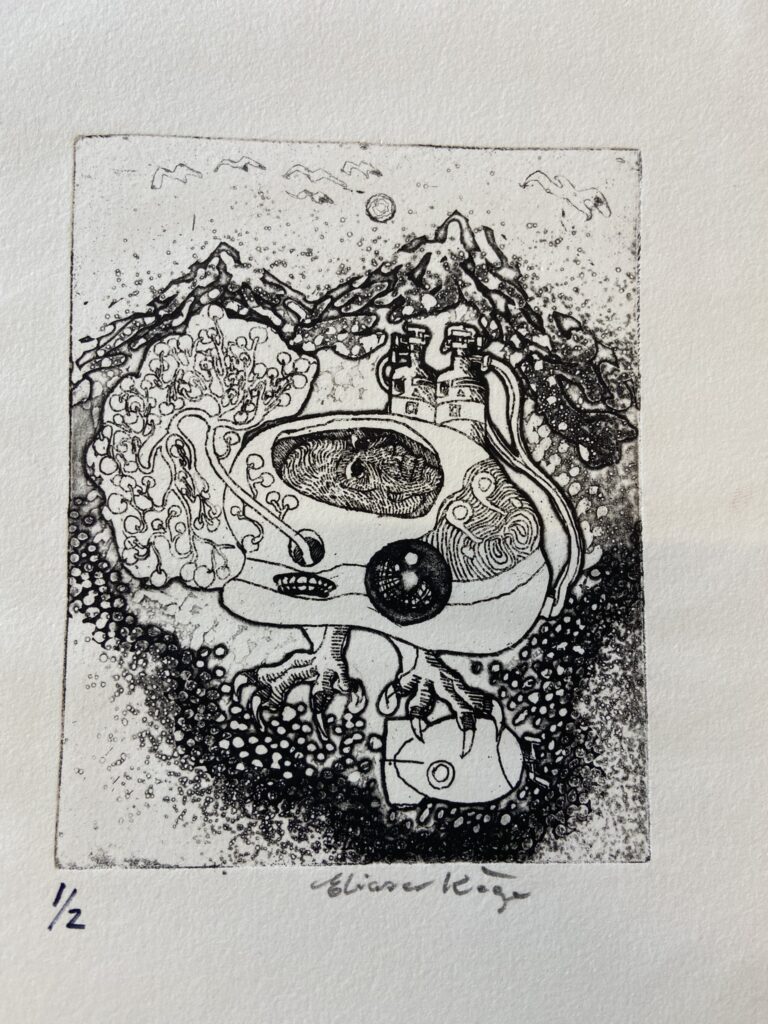Grafisk Værksted opened in 1972 and became the Greenland Art School at the end of 1980. It was Hans Lynge and Bodil Kaalund, both artists and authors, who opened the workshop as a private undertaking in the former bathhouse in Nuuk. The idea for the workshop was inspired by the graphic workshop in Cape Dorset, Canada. In the years between 1972 and 1980, courses were offered in various graphic techniques such as lithography, serigraphy, copperplate printing and linoleum printing.
The school has over time had prominent leaders and teachers such as Emil Rosing, Jessie Kleemann, and Arnannguaq Høegh. The students came from all over Greenland and had different backgrounds – hunters, fishermen, craftsmen, housewives, sailors and young people who were interested in art. Some of these were Jessie Kleemann, Anne-Birthe Hove, Frederik Kristensen ‘Kunngi’, Aka Høegh and Thue Christiansen.
The collection of works from Grafisk Værksted is housed by the Greenland National Museum and Archives and from here approx. 100 works are borrowed the exhibition. The works in the exhibition reflect the range of the students in terms of technique, motifs and expression. The motifs vary from subjects such as love, landscapes, the immediate surroundings, portraits, hunting scenes, inspiration from the world and non-figurative motifs.
Grafisk Værksted has for many been the way to a career as an artist, and since 1980 as the Greenland Art School, the school has served as a springboard to art academies around the world. The school has most likely been the most important shift in the development of professionalization of art that Greenland experienced since the 1970s, and has played a crucial role in Greenlandic art. Still, it is very difficult to find information about the school. You can find an article here and there, but few books mention the school, and there is only a little archival material to be found at the National Archives of Greenland. It is planned that a catalog will be published during the summer in collaboration with the Greenland Art School in connection with the exhibition, and the hope is that it will contribute to more accessible knowledge about the school.
Exhibiting students from Grafisk Værksted:
Aka Høegh, Amalie Lennart, Angu, Ejnar Jensen, Elisabeth, Anne-Birthe Hove, Aqqa Geisler, Astrid Heilmann, Bent Warney, Ejnar Heilmann, Eliaser Qeqe, Elisa Olsen, Enok Absalonsen, Eva Marie Stoltz, Hans Manikutdlak, Henrik Johansen, Inukitsorujuk Quist, Jens Stach, Jeremias Karlsen, Jessie Kleemann, Johanne Simonsen, Jonas Zethsen, Kaka, Karl H. Olsen, Frederik Kristensen Kunngi, Lasse Davidsen, Malo Nielsen, Maqqa Karlsen, Marianne Jessen, Marie Lyberth, Naja Kruse, Nikoline Kilime, Nuka Poulsen, Salomon Winding, Samo Kajussen, Thue Christiansen, and Tønnes Petersen.
The title of the exhibition is “Puilanerit // Grafisk Værksted 1972-1980”. Puilanerit means “spring (of water)” and refers to the students as springs in the art scene, thoughts and ideas that emerge through the works, and the school as the source of Greenland’s art today. The curation of the exhibition was determined by the collection of works, ie. artists, students, graphic techniques, and existing knowledge have not determined the design of the exhibition.
The exhibition opens on Greenland’s National Day on the 21st of June at 3 pm and can be seen until the 2nd of October 2022. The current principal at the art school, artist Ivínguak ’Stork Høegh, will be present at the opening.
The exhibition is funded by the Greenland Self-Government’s Tips og Lottomidler funds and the works are borrowed from the Greenland National Museum and the Archives’ magazines.

